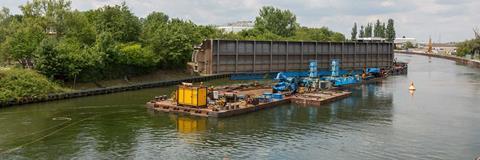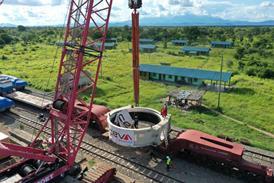Heavy transport engineering provider Felbermayr was awarded the contract to dismantle an old flood barrier near Ladenburg on the river Neckar in Germany. Due to tight confines, it was necessary to disassemble the 210-tonne structure directly on the water.

The old barrier – which was put into operation in 1931 – was sandwiched between the new flood barrier and a bridge. “Our task was to remove the flood barrier in a single piece, which meant we needed to find a solution that would allow the barrier gate to be raised from the bearings on site, then horizontally rotated on the water for removal,” explained Kees Kompier, divisional manager at Felbermayr’s engineered solutions division.
The barrier measured 45 m wide and roughly 5.1 m high. To perform the job directly on the water, Felbermayr used a 66 m-long, 11 m-wide pontoon as a floatation device. This was extended with side pontoons on site to guarantee the required stability. “Positioned lengthwise on it were two six-axle SPMT modules, each with so-called ‘elephant feet’, which were fitted with two steel beams that would later bear the flood barrier. A climbing jack system consisting of four 3.8 m-high jacking towers was also on hand to assist. The barrier was to be subsequently placed on this system and then driven out according to the engineering plan,” said Kompier.
Once the preparatory work was complete, the pontoon assembly was positioned precisely beneath the old flood barrier by six winches, after which it immediately took over around twenty percent of the total weight by pumping out ballast water.
The next day, the flood barrier was lifted out by further deballasting water bailing and use of the stroke of the SPMT module. “It was raised around 1.7 m so that the structure was roughly 10 cm clear of the building level, after which it could be rotated 26 degrees in the direction of the climbing jacks by the SPMTs and lower down on the towers,” explained Kompier.
The flood barrier was then jacked down onto SPMTS. This process, along with taking on ballast water, brought the pontoon assembly to a sufficiently low level that the old barrier could be manoeuvred beneath the new flood barrier with a clearance of around 15 cm, before being floated to the quay.
Finally, preparations were made for transportation on the Neckar to Mannheim. To this end, the barrier was placed directly on the stacking lift system and steel beams. The SPMT modules were dismantled.
















